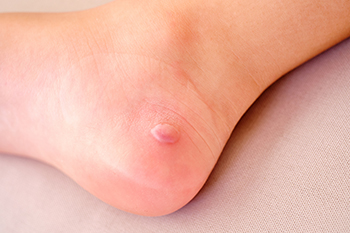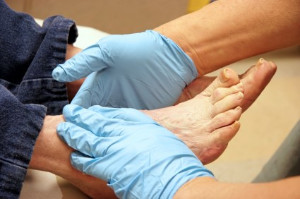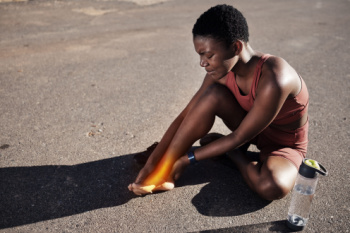
Fracture blisters are fluid-filled lesions that develop on the skin near a broken bone, usually in areas with little soft tissue such as the ankle or foot. These blisters form due to increased pressure and shearing forces during a traumatic injury. Common causes include severe fractures, particularly from high-impact incidents. Symptoms involve tense or blood-filled blisters, swelling, and pain. Risk factors include diabetes, vascular disease, and delayed medical attention. A podiatrist can assess the injury, prevent or treat an infection, and guide proper wound care and immobilization. Prompt evaluation ensures healing without complications. If you notice blistering near a foot injury, it is strongly suggested that you seek expert podiatric care immediately.
Blisters may appear as a single bubble or in a cluster. They can cause a lot of pain and may be filled with pus, blood, or watery serum. If your feet are hurting, contact Lance Greiff, DPM of Great Neck Podiatry. Our doctor can provide the care you need to keep you pain-free and on your feet.
Foot Blisters
Foot blisters are often the result of friction. This happens due to the constant rubbing from shoes, which can lead to pain.
What Are Foot Blisters?
A foot blister is a small fluid-filled pocket that forms on the upper-most layer of the skin. Blisters are filled with clear fluid and can lead to blood drainage or pus if the area becomes infected.
Symptoms
(Blister symptoms may vary depending on what is causing them)
- Bubble of skin filled with fluid
- Redness
- Moderate to severe pain
- Itching
Prevention & Treatment
In order to prevent blisters, you should be sure to wear comfortable shoes with socks that cushion your feet and absorb sweat. Breaking a blister open may increase your chances of developing an infection. However, if your blister breaks, you should wash the area with soap and water immediately and then apply a bandage to the affected area. If your blisters cause severe pain it is important that you call your podiatrist right away.
If you have any questions, please feel free to contact our offices located in Great Neck Bronx, NY . We offer the newest diagnostic and treatment technologies for all your foot care needs.

Diabetic foot care is important because high blood sugar levels can damage nerves and reduce blood flow to the feet. This leads to a loss of sensation, called neuropathy, which makes it hard to feel pain, temperature, or injuries. Poor circulation also slows healing, which increases the risk of infections and serious complications. Common symptoms include numbness, tingling, burning, dry or cracked skin, and slow-healing wounds. Feet may appear discolored, swollen, or develop ulcers without noticeable pain. These changes can lead to serious issues if not treated early. A podiatrist can assess circulation, nerve function, and inspect for wounds or deformities. Regular check-ups, proper nail trimming, custom footwear, and wound care are key parts of treatment. Prevention includes daily foot checks, washing and moisturizing the feet, and wearing well-fitting shoes. If you have diabetes, it is suggested that you make an appointment with a podiatrist for ongoing evaluation and treatment.
Diabetic foot care is important in preventing foot ailments such as ulcers. If you are suffering from diabetes or have any other concerns about your feet, contact Lance Greiff, DPM from Great Neck Podiatry. Our doctor can provide the care you need to keep you pain-free and on your feet.
Diabetic Foot Care
Diabetes affects millions of people every year. The condition can damage blood vessels in many parts of the body, especially the feet. Because of this, taking care of your feet is essential if you have diabetes, and having a podiatrist help monitor your foot health is highly recommended.
The Importance of Caring for Your Feet
- Routinely inspect your feet for bruises or sores.
- Wear socks that fit your feet comfortably.
- Wear comfortable shoes that provide adequate support.
Patients with diabetes should have their doctor monitor their blood levels, as blood sugar levels play such a huge role in diabetic care. Monitoring these levels on a regular basis is highly advised.
It is always best to inform your healthcare professional of any concerns you may have regarding your feet, especially for diabetic patients. Early treatment and routine foot examinations are keys to maintaining proper health, especially because severe complications can arise if proper treatment is not applied.
If you have any questions please feel free to contact our offices located in Great Neck Bronx, NY . We offer the newest diagnostic and treatment technologies for all your foot and ankle needs.

Everyday foot problems such as soreness, blisters, bunions, and hammertoes can often be managed with regular care and supportive footwear. Shoes that provide enough room in the toe area help reduce pressure on bunions and allow space for bent toes caused by hammertoes. Soft padding and protective inserts may improve comfort and reduce friction. Keeping feet clean and moisturized helps prevent dry skin and irritation, while proper nail trimming lowers the risk of ingrown nails. Gentle exercises and stretching can improve circulation and maintain flexibility, especially in stiff or tired feet. Ignoring foot discomfort may lead to worsening symptoms or structural changes. If you are dealing with bunions, hammertoes, or any other persistent foot issue, it is suggested that you see a podiatrist for a diagnosis and treatment plan that helps maintain comfort, mobility, and long-term foot health.
Foot Pain
Foot pain can be extremely painful and debilitating. If you have a foot pain, consult with Lance Greiff, DPM from Great Neck Podiatry. Our doctor will assess your condition and provide you with quality foot and ankle treatment.
Causes
Foot pain is a very broad condition that could be caused by one or more ailments. The most common include:
- Bunions
- Hammertoes
- Plantar Fasciitis
- Bone Spurs
- Corns
- Tarsal Tunnel Syndrome
- Ingrown Toenails
- Arthritis (such as Gout, Rheumatoid, and Osteoarthritis)
- Flat Feet
- Injury (from stress fractures, broken toe, foot, ankle, Achilles tendon ruptures, and sprains)
- And more
Diagnosis
To figure out the cause of foot pain, podiatrists utilize several different methods. This can range from simple visual inspections and sensation tests to X-rays and MRI scans. Prior medical history, family medical history, and any recent physical traumatic events will all be taken into consideration for a proper diagnosis.
Treatment
Treatment depends upon the cause of the foot pain. Whether it is resting, staying off the foot, or having surgery; podiatrists have a number of treatment options available for foot pain.
If you have any questions, please feel free to contact our offices located in Great Neck Bronx, NY . We offer the newest diagnostic and treatment technologies for all your foot care needs.

Hammertoe is a deformity in which one or more of the smaller toes, most commonly the second toe, bends abnormally at the middle joint, often creating a Z-shaped angle. A hammertoe may develop due to tendon imbalances, long toe bones, joint misalignment, or long-term use of wearing tight shoes. Rheumatoid arthritis can also be a contributing factor. People with hammertoe often experience pain when wearing shoes with a narrow toe box. Friction within the shoe can lead to the formation of corns, calluses, or even open sores on the top of the bent toe. Pain may also occur in the ball of the foot. After examining the hammertoe, a podiatrist may recommend custom orthotics to reduce pressure and relieve discomfort. In cases where the toe deformity becomes rigid and painful, surgery may be considered to realign the joints in the toe. If you have a hammertoe deformity that is causing pain, it is suggested that you schedule an appointment with a podiatrist for an exam and appropriate treatment options.
Hammertoe
Hammertoes can be a painful condition to live with. For more information, contact Lance Greiff, DPM from Great Neck Podiatry. Our doctor will answer any of your foot- and ankle-related questions.
Hammertoe is a foot deformity that affects the joints of the second, third, fourth, or fifth toes of your feet. It is a painful foot condition in which these toes curl and arch up, which can often lead to pain when wearing footwear.
Symptoms
- Pain in the affected toes
- Development of corns or calluses due to friction
- Inflammation
- Redness
- Contracture of the toes
Causes
Genetics – People who are genetically predisposed to hammertoe are often more susceptible
Arthritis – Because arthritis affects the joints in your toes, further deformities stemming from arthritis can occur
Trauma – Direct trauma to the toes could potentially lead to hammertoe
Ill-fitting shoes – Undue pressure on the front of the toes from ill-fitting shoes can potentially lead to the development of hammertoe
Treatment
Orthotics – Custom made inserts can be used to help relieve pressure placed on the toes and therefore relieve some of the pain associated with it
Medications – Oral medications such as anti-inflammatories or NSAIDs could be used to treat the pain and inflammation hammertoes causes. Injections of corticosteroids are also sometimes used
Surgery – In more severe cases where the hammertoes have become more rigid, foot surgery is a potential option
If you have any questions please contact our offices located in Great Neck Bronx, NY . We offer the newest diagnostic and treatment technologies for all your foot and ankle needs.
